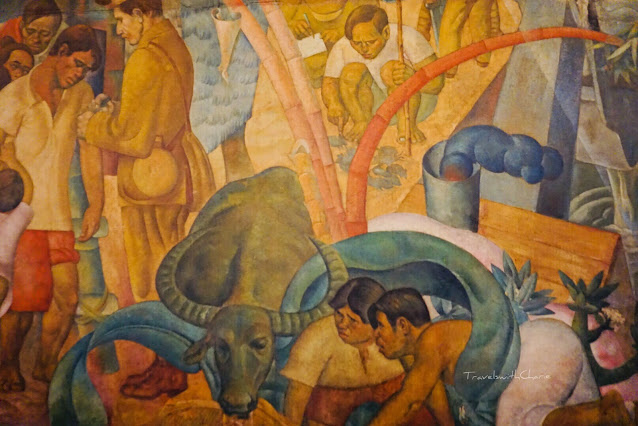Pre-colonial period
Pag-unlad ng Panggagamot sa Pilipinas (The Progress of Medicine in the Philippines) is a group of four large-scale paintings depicting healing practices in the Philippines from pre-colonial times to the modern period. Carlos Botong Francisco was commissioned in 1953 by Dr. Agerico Sison who was then the director of Philippine General Hospital (PGH) together with Dr. Eduardo Quisumbing of the National Museum, Dr. Florentino Herrera, Jr. and Dr. Constantino Manahan. These oil on canvas paintings measure 2.92 meters in height and 2.76 meters in width (9.71 ft x 8.92 ft) and were displayed at the main entrance hall of PGH for over five decades. Owing to its location, the artworks were in a state of "severe deterioration" at the beginning of the 21st century from exposure to heat, humidity, dirt, dust, smoke, insect stains, grime, termites and an oxidized synthetic resin used in an earlier restoration. These canvases were restored three times, the last was in 2006 which restoration was financially supported by the U.S. Department of State through the Ambassadors Fund for Cultural Preservation. PGH and the University of the Philippines decided in 2010 to loan the paintings to the National Museum of the Philippines where they could be displayed in an environmentally controlled setting and properly maintained. The quadtych was transferred to the National Museum in 2011 and the National Museum in turn provided reproductions of the original paintings to PGH.
The first painting above depicts a babaylan (female shaman), with hands uplifted, leading a healing ritual in pre-colonial Philippines. The fire is lit for the sacrificial offering of the pig (on the lower right corner in the foreground) and the villagers, led by their chief, are gathered around the sick person.
Detail from Colonial panel
Botong as he was fondly called by friends, worked in the film industry as a scriptwriter and production designer. These paintings show some influences from his experience in film production, particularly his mastery in storytelling through his paintbrush. |
| The American Period |
 |
| A section of the American Period |
 |
| Modern Medicine |
It's interesting to note that Botong incorporated his first two panels of Progress of Medicine (on display at PGH entrance hall) on the lower left corner of this painting.
Botong connects the four panels through common elements like flora and clouds. Note the two decorated bamboo poles in the pre-Colonial canvas, a tree trunk and foliage are integral parts of the scene in the Colonial panel, bent bamboo stalks form a curve line in the American Period panel and trees are not afterthoughts in the left middle ground of the Modern Medicine canvas. Spiraling clouds appear conspicuously in the first two panels, the poisonous clouds of fumigation kills the rodents in the third canvas and the atomic mushroom cloud figures prominently on the upper left corner of the last panel.
Progress of Medicine in the Philippines was declared a National Cultural Treasure in 2011. The quadtych is in Gallery X, MFP Hall at the National Museum of the Philippines. Carlos Botong Francisco is a 1973 National Artist Awardee for the Visual Arts.
If you would like to learn more about the artworks by Carlos Botong Francisco, check the links below:
https://www.travelswithcharie.com/search?q=Carlos+Botong+Francisco
https://www.travelswithcharie.com/2016/08/this-small-museum-packs-punch.html
https://www.travelswithcharie.com/2018/05/masterpieces-from-national-museum-of.html
 |
| Progress of Medicine in the Philippines |
 |
| Progress of Medicine in the Philippines |
If you would like to learn more about the artworks by Carlos Botong Francisco, check the links below:
https://www.travelswithcharie.com/search?q=Carlos+Botong+Francisco
https://www.travelswithcharie.com/2016/08/this-small-museum-packs-punch.html
https://www.travelswithcharie.com/2018/05/masterpieces-from-national-museum-of.html
https://www.travelswithcharie.com/2023/06/carlos-botong-francisco-evolution-of.html
Visitor Information:
National Museum of the Philippines
Padre Burgos Drive, Rizal Park, Manila
www.nationalmuseum.gov.ph
The museum is free of charge to all visitors. No bags are allowed inside the museum. There is a coat check counter beside the reception desk where you can leave your belongings. Taking photos without flash is allowed.
Hours of operation: Tuesdays to Sundays, 10 a.m. to 5 p.m.
Stay connected

Visitor Information:
National Museum of the Philippines
Padre Burgos Drive, Rizal Park, Manila
www.nationalmuseum.gov.ph
The museum is free of charge to all visitors. No bags are allowed inside the museum. There is a coat check counter beside the reception desk where you can leave your belongings. Taking photos without flash is allowed.
Hours of operation: Tuesdays to Sundays, 10 a.m. to 5 p.m.
Stay connected
*****
Images by TravelswithCharie
Images by TravelswithCharie



